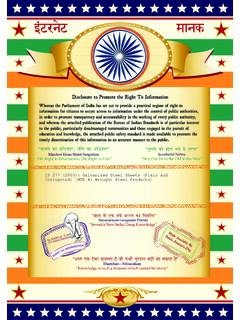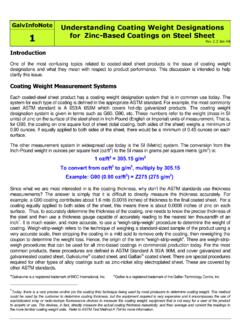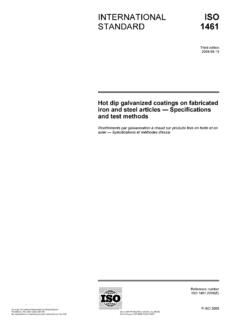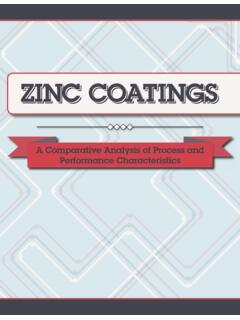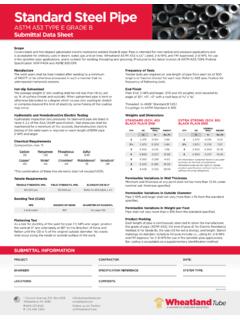Transcription of Hot Dip Galvanizing and corrosion - Nordic Galvanizers
1 corrosion ratesEN ISO 12944-2 specifies the corrosion categories C1 to C5. The corrosion categories show the corrosion loss on zinc and steel as shown in table 2. Table 3 provides examples of related corrosion environments. corrosion rates of common structural steel and zinc are based partly on results from field exposure, partly on practical experience from galvanized steel 4 presents the life time of the zinc coating with layer thicknesses according to standard EN ISO 1461:2009. The table also include thicknesses of at least 115, 165 and 215 microns, that can be achieved on steel with specified silicon content and thickness above 6 mm. Some comments on the different corrosion categories are given below: corrosion category C1, C2 and C3 Hot dip Galvanizing results in a corrosion protection which normally has a very long life in these corrosion categories and can be used without any Category C4 The lowest coating thicknesses of 45 microns, which are created on thin parts, results in a moderate life span in this cor-rosion category.
2 However, this does not lead to any problems if the steel parts are interchangeable, so that regalvanizing is possible, or if the parts are accessible for maintenance with other anti- corrosion replacement or maintenance is not possible, it may be desirable to have a corrosion protection with a very long du-rability. This can be achieved with coating thicknesses of 115, 165 or 215 microns, as shown in Table large thicknesses can be reached only if previously agreed with the galvanizer, and when reactive steel has been choosen. Coating thickness ( m) Optimal silicon level (%) Silicon range (%)Fe/Zn 115 0,18 0,15-0,21Fe/Zn 165 0,25 0,22-0,28Fe/Zn 215 0,32 0,29-0,35 Table and range values for silicon when higher coating thicknesses are of a minimum of 115 microns in local coating thickness can also be met on steel with low silicon content when the steel before Galvanizing is sandblasted so the the surface roughness is minimum Ra 121/2 category C5 This category includes the most corrosive atmospheric conditions that may occur locally at the western coasts or at par-ticularly polluted industrial and urban areas.
3 The thinnest zinc coatings will have shorter life under these conditions, and duplex treatment (= Galvanizing + paint) might be needed. In water and soilEN ISO 12944-2 also contains corrosion categories for steel structures which are immersed in water (Im1, Im2) or buried in soil (Im3), but it is here difficult to give general guidelines for when hot dip Galvanizing can be used alone, or when it is necessary to use duplex treatment. The corrosion conditions should be evaluated in each separate Dip Galvanizing and corrosioncategoriesRev 4 October 2017In which corrsion categories could galvanized steel be used? This question is frequently asked when only a specific corrosion category is specified. Such a specification is insuf-ficient, since corrosion categories only indicates fairly wide limits for the environment where the construction will be exposed, but without specifying the type of protection or life time for the construction.
4 A more detailed specification for the corrosion protection is needed, considering the requirements regarding durability and time to first maintenance. This information sheet is intended to provide information about the possibilities to use hot-dip Galvanizing in different corrosion categories. It will usually be necessary to use duplex to achieve long-term protection in the following environments: In almost constantly moist environment In highly acidic or highly alkaline environments In more corrosive soils as loamy soil and peat and peat soilBy proper pre-treatment of zinc surfaces prior to coating, as described in Nordic Galvanizers Galvanizing Handbook , it is possible to obtain adequate durability for most categoryMass loss for surface unit and thickness reduction (1 year of exposure)SteelZincMass loss(g/m2)Thickness reduction ( m)Mass loss(g/m2)Thickness reduction ( m)C1 10 1,3 0,7 0,1C2> 10-200>1,3-25> 0,7-5> 0,1-0,7C3> 200-400> 25-50> 5-15> 0,7-2,1C4> 400-650> 50-80>15-30> 2,1-4,2C5-I> 650-1500> 80-200> 30-60> 4,2-8,4C5-M> 650-150080-200> 30-60> 4,2-8,4 Table 2.
5 Atmospheric corrosion categoriesCorrosioncategoryExamples of typical corrosion environmentsC1 Very lowHeated buildings with clean atmospheres, offices, shops, schools, LowUnheated buildings where condensation may occur, depots, sports with low level of pollution. Mostly rural MiddleProduction rooms with high humidity and some air pollution food-processing plants, laundries, breweries and and industrial atmospheres, moderate sulfur dioxide pollution. Coastal areas with low HighChemical plants, swimming pools, coastal ship- and areas and coastal areas with moderate (I+M)Very highBuildings or areas with almost permanent condensation and with high pollution. Coastal and offshore areas with high 3.
6 Examples of typical corrosion environments according to EN ISO categoryCoating thicknessC3Fe/Zn according to EN ISO 1461:2009C4Fe/Zn 115 m according to Steels suitable for Galvanizing C5Fe/Zn 215 m according to Steels suitable for Galvanizing or Duplex ( Galvanizing + painting)Table 5. Suitable corrosion protection for exposure in different corrosivity classes +46 (0)8 446 67 60 4. The life in years for galvanized coatings used in corrosion categories C1 -C5. The lifetimes are based on minimum local coating thickness according to EN ISO 1461 thicknesses according to EN ISO 14611 Life time of zinc coating in different corrosion categoriesSteel thicknessmm(Local coatingthickness3)Mean thickness4 mC1C2C3C4C55 steel > 6 mm(70) 85100+100-100+40-100+20-4010-20 steel > 3 - 6 mm(55) 70100+100-100+33-10017-338-17 steel 1,5 - 3 mm(45) 55100+78-100+26-7813-266-13 steel < 1,5 mm(35) 45100+64-100+21-6411-215-11 Castings 6 mm(70) 80100+100-100+38-100+19-3810-19 Castings < 6 mm(60) 70100+100-100+33-10017-338-17 steel > 6 mm Special2(100) 115100+100+55-100+27-5514-27 steel > 6 mm Special2(145)
7 165100+100+78-100+39-7820-39 steel > 6 mm Special2(190) 215100+100+100-100+39-100+25-51 Notes:1) Minimum coating thickness on samples that are not ) Larger coating thicknesses can only be achieved when the steel has a specified silicon ) Minimum local coating thickness according to EN ISO 1461 ) Mean coating thickness according to EN ISO 1461 ) In category C5 it may be necessary to use duplex ( Galvanizing + painting) to reach longer life information is provided by.
